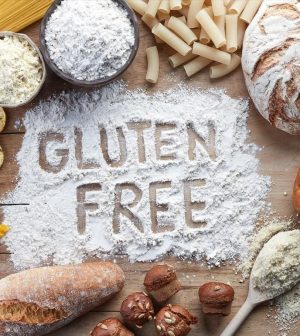- See What Saffron Can Do for Sleep and Heart Health
- 6 Common Mistakes to Avoid Before Your Physical
- Can Sweating Really Help You Beat a Cold?
- Strengthening Your Relationship: Practical Strategies
- Skip Storing This Everyday Product in the Fridge Door
- Green Tea + B3 Pairing May Boost Brain Health
- Navigating Your Midlife Crisis: Embracing New Possibilities
- City Raccoons Showing Signs of Domestication
- Mapping the Exposome: Science Broadens Focus to Environmental Disease Triggers
- One Week Less on Social Media Linked to Better Mental Health
What Is Celiac Disease?

Celiac disease is a chronic disease that can’t be cured, but treatment can help with symptoms.
This guide will break down what you need to know about celiac disease, including its causes and symptoms, along with self-care and treatment. You’ll also learn more about the celiac disease diet, especially foods to eat and those to avoid.
What is celiac disease?
Celiac disease is “a serious autoimmune disease” that runs in families, according to the Celiac Disease Foundation. In people with celiac, eating foods that contain gluten leads to damage in the small intestine.
Gluten is a protein found in wheat, rye and barley. If you live with celiac disease, even a crumb of food can trigger symptoms and injure the small intestine.
Celiac disease causes
Celiac is found only in people who have specific genes and consume food containing gluten. Gluten does not cause the disease but triggers the abnormal immune response. Other factors may contribute to developing celiac disease, including a higher number of infections early in life, according to the U.S. National Institute of Diabetes and Digestive and Kidney Diseases. Changes in the gut microbiome may also play a role. The microbiome is involved in digestion.
Celiac disease symptoms
The Celiac Disease Foundation notes 200 known symptoms of the disease. The most common are:
- Bloating
- Chronic diarrhea
- Constipation
- Gas
- Lactose intolerance
- Loose, greasy, bulky and bad-smelling stools
- Nausea or vomiting
- Abdominal pain
Children with celiac disease may show symptoms of:
- Failure to thrive
- Delayed puberty
- Damage to teeth enamel
- Slowed growth
- Weight loss
- Mood changes
Symptoms of celiac disease that affect other parts of the body are:
- Dermatitis herpetiformis, an intensely itchy, blistering symptom also known as celiac disease rash
- Fatigue
- Joint or bone pain
- Mental health problems
- Nervous system symptoms such as headaches, balance problems, seizures, peripheral neuropathy
- Reproductive issues in women and girls
- Canker sores, dry mouth or a red, shiny, smooth tongue
Celiac disease diagnosis
Testing for celiac disease is typically done through a pair of blood tests. One checks for elevated levels of antibodies that indicate an immune reaction to gluten. Genetic testing for human leukocyte antigens (HLA-DQ2 and HLA DQ8) can be used to rule out celiac disease, according to the Mayo Clinic.
It is important to be tested before trying a gluten-free diet. That’s because if you eliminate gluten before testing, your results may be invalid. Your health care provider may also order an endoscopy, a procedure that allows a sample of tissue to be taken from the small intestine for analysis. A capsule endoscopy may also be ordered. It uses a tiny, wireless camera to take pictures of your intestine. The camera is placed in a capsule the size of a vitamin and is swallowed like a pill.
Can a specific diet help with symptoms?
A gluten-free diet is the only treatment for celiac disease, Johns Hopkins University says. Even the slightest amount of gluten can trigger a reaction and damage your small intestine.
These are foods to avoid on a gluten-free diet:
- Wheat
- Rye
- Barley
- Triticale (a cross between wheat and rye)
These foods may also contain gluten:
- Beer, ales and lager
- Bouillon
- Brown rice syrup
- Candy
- Chips
- Cold cuts
- Communion wafers
- French fries
- Imitation fish
- Matzo
- Rice mixes
- Sauces
- Soy sauce
- Veggies in sauces
It is also important to check all over-the-counter and prescription drugs because they, too, may contain gluten.
Celiac disease medication
There is no cure or treatment for celiac disease other than a gluten-free diet. Medications such as steroids may be used if your intestine is inflamed or damaged, according to the Mayo Clinic. In severe cases, drugs used to treat autoimmune diseases, such as azathioprine (Azasan, Imuran) or budesonide (Entocort EC, Uceris), may relieve symptoms.
Celiac disease self-care
It’s important to practice good self-care, because celiac disease may increase your risk for developing other health issues, including heart disease, according to a 2022 study published in BMJ Medicine. “Cardiovascular risk scores used in clinical practice might therefore not adequately capture the excess risk of cardiovascular disease in people with celiac disease, and clinicians should be aware of the need to optimize cardiovascular health in this population,” said authors led by Megan Conroy, of University of Oxford in the U.K.
Following a celiac diet and any other treatments recommended by your health care provider, including screenings for other health issues is essential.
When dining out, it is essential to understand how the food is prepared. Is the same fry basket used for both gluten and gluten-free items? Cross-contamination isn’t always easy to avoid. It may help to call ahead and speak with the restaurant to understand what is safe to consume. Maintaining separate cooking tools and preparing meals in different areas will prevent cross-contamination if others in your household consume gluten.
Source: HealthDay
Copyright © 2025 HealthDay. All rights reserved.










